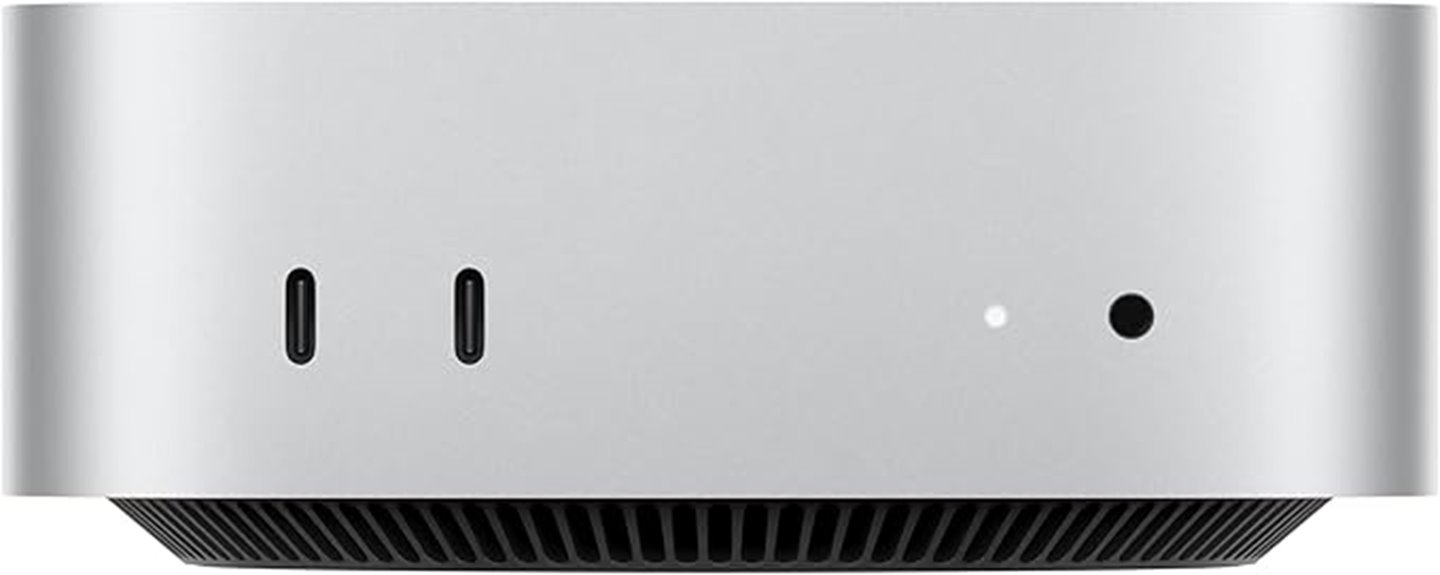If you’re setting up an efficient media server in 2025, I recommend considering the latest Mac Minis with the M4 chip, especially models with 16GB or 24GB of RAM and up to 2TB SSD for ample storage. The M4 and M4 Pro versions give you powerful CPUs and support multiple high-res displays, perfect for media streaming or transcoding. To find out which model suits your needs best, keep exploring the options I’ve outlined.
Key Takeaways
- Choose models with the M4 or M4 Pro chip for optimal multitasking and media processing power.
- Prioritize Mac Minis with at least 512GB SSD and support for multiple high-resolution displays.
- Opt for versions with Thunderbolt 4, HDMI, and Ethernet ports to ensure robust connectivity.
- Consider models with 16GB or more RAM for smooth streaming, transcoding, and media management.
- Select energy-efficient Mac Minis with quiet operation and scalable storage options for long-term use.
Apple Mac mini Desktop Computer with M4 Chip (2024)

If you’re looking for a compact yet powerful media server, the Apple Mac mini with M4 chip (2024) is an excellent choice, especially for those who need to support multiple high-resolution displays and handle demanding tasks like video editing or streaming. Its five-by-five-inch design fits neatly on any desk or next to monitors, while its sleek, modern look enhances your workspace. Powered by the robust M4 chip with a 10-core CPU and GPU, plus up to 32GB of memory, it delivers fast multitasking and smooth performance. With support for up to three 6K, 5K, or 8K displays, it’s perfect for media-heavy setups.
Best For: users seeking a compact, high-performance media server capable of supporting multiple high-resolution displays and demanding creative tasks.
Pros:
- Small, space-saving design ideal for clutter-free setups and versatile placement
- Powerful M4 chip with 10-core CPU and GPU ensures fast multitasking and media processing
- Supports up to three 6K, 5K, or 8K displays for immersive media experiences
Cons:
- Limited internal SSD capacity may require external storage for large media libraries
- No dedicated GPU options, which could impact intensive gaming or 3D rendering
- Requires external peripherals for expansion and additional connectivity needs
Apple Mac mini Desktop Computer with M4 Chip and 16GB RAM

The Apple Mac mini with M4 chip and 16GB RAM is an excellent choice for those looking to run a reliable media server in a compact space. Its powerful 10-core CPU and GPU deliver fast, smooth performance, perfect for streaming and managing large media libraries. The 16GB unified memory ensures multitasking runs seamlessly, while the 512GB SSD provides quick access to files. Its small footprint, measuring just five by five inches, makes it easy to place next to your monitor or in tight spots. With extensive connectivity options like Thunderbolt, HDMI, and Gigabit Ethernet, it’s versatile and ready to handle all your media needs efficiently.
Best For: users seeking a compact, powerful desktop computer to serve as a reliable media server with seamless media management and streaming capabilities.
Pros:
- Compact size fits easily into small spaces and next to monitors
- Powerful 10-core CPU and GPU deliver smooth, fast performance for media tasks
- Extensive connectivity options support various media devices and streaming setups
Cons:
- Limited internal storage capacity might require external drives for large media libraries
- No dedicated graphics card, which may limit high-end gaming or intensive multimedia editing
- Upgrading hardware components post-purchase is not user-accessible
Apple Mac mini Desktop Computer with M4 Pro chip

Powered by the M4 Pro chip, the Apple Mac mini offers an impressive combination of power and compactness, making it ideal for media servers in space-constrained environments. Its small footprint (5×5 inches, 2 inches high) fits easily next to monitors and is highly portable. The M4 Pro’s 12-core CPU, 16-core GPU, and hardware-accelerated ray tracing deliver robust performance for multitasking, video processing, and media streaming. With up to 24GB of unified memory and fast SSD options, it handles demanding tasks smoothly. Support for multiple 6K displays, Thunderbolt 5, and HDR formats guarantees it’s versatile for media-heavy applications, all in a sleek, quiet design.
Best For: creative professionals, media enthusiasts, and space-conscious users seeking a powerful, compact desktop for multitasking, media editing, and streaming.
Pros:
- Extremely compact and portable design fits seamlessly into any workspace
- Powerful M4 Pro chip with high-performance CPU and GPU for demanding tasks
- Supports multiple high-resolution displays and fast connectivity options
Cons:
- Limited internal storage options may require external drives or cloud solutions
- Minor setup challenges or compatibility issues with certain monitors, easily resolved with proper cables
- Slightly higher price point compared to some compact Windows alternatives
Apple 2024 Mac mini Desktop Computer with M4 Chip

The Apple 2024 Mac mini with the M4 chip stands out as an excellent choice for those setting up a media server, thanks to its compact size and powerful hardware. Its five-by-five-inch design fits neatly next to a monitor and runs quietly, staying cool under load. The M4 chip delivers a 10-core CPU and GPU, along with 24GB of unified memory—upgradable to 32GB—and fast SSD options up to 2TB. It supports multiple high-resolution displays and formats like HDR and AV1. With robust connectivity, including Thunderbolt 4, HDMI, Ethernet, and Wi-Fi 6E, it’s ideal for seamless media streaming, transcoding, and storage management.
Best For: individuals seeking a compact, powerful media server for streaming, transcoding, and storage management with seamless Apple ecosystem integration.
Pros:
- Compact size with sleek, quiet operation; fits easily next to monitors
- Powerful M4 chip with high-performance CPU and GPU, supports multiple high-res displays
- Wide connectivity options including Thunderbolt 4, HDMI, Ethernet, and Wi-Fi 6E
Cons:
- Limited internal storage capacity at base, requiring external drives for expansion
- Slightly higher price point compared to traditional mini PCs with similar specs
- Some minor user reports of display wake-up issues or storage concerns
Factors to Consider When Choosing Mac Mini as a Media Server

When selecting a Mac Mini for a media server, I focus on several key factors. I consider the processing power I need, storage options, and how well it connects with my media apps and network. Understanding these points helps me choose a model that fits my setup and performance requirements.
Processing Power Needs
Choosing a Mac Mini as a media server requires careful consideration of its processing power because it directly impacts your ability to transcode, stream, and manage multiple media files smoothly. Higher processing power enables efficient handling of demanding tasks like real-time transcoding and multi-device streaming without lag. CPUs with more cores, such as 8 or 12, can easily support simultaneous media playback, editing, and server management. This guarantees smooth operation when running media server software and managing large libraries. Additionally, processors with dedicated media engines and hardware-accelerated encoding benefit users who need advanced features. Balancing processing capabilities with other factors like storage and connectivity is essential to meet your specific media management needs effectively.
Storage Capacity Options
Selecting the right storage capacity for your Mac Mini is essential to guarantee smooth media server operation and easy access to your files. I recommend choosing at least 512GB of SSD storage to comfortably hold media files, applications, and system updates. If you plan to store large video collections, high-resolution photos, or extensive music libraries, consider options like 1TB or 2TB. External SSDs or HDDs are excellent for expanding storage, especially if internal options are limited or more budget-friendly. Keep in mind, internal storage impacts the server’s efficiency; more internal space means less reliance on external drives and faster access speeds. Balancing initial costs with future needs is vital, as higher internal storage offers greater convenience and performance down the line.
Connectivity Features
To guarantee your Mac Mini functions effectively as a media server, paying close attention to its connectivity features is essential. You’ll want multiple Thunderbolt 4 and USB-C ports to connect external storage and peripherals seamlessly, ensuring smooth data transfer. HDMI ports are crucial for high-quality media streaming, while Ethernet ports—preferably Gigabit or 10Gb Ethernet—provide a stable, fast internet connection critical for serving media reliably. Supporting Wi-Fi 6E and Bluetooth 5.3 ensures high-speed wireless connectivity with compatible devices, reducing lag and improving user experience. Additionally, audio output options like a headphone jack and HDMI multichannel audio support give you versatile media playback options. These connectivity features collectively ensure your Mac Mini can handle all media server demands efficiently.
Compatibility With Media Apps
When evaluating a Mac Mini as a media server, it’s important to guarantee it can run the media applications you plan to use without issues. First, ensure it supports the latest macOS version to keep apps running smoothly. Compatibility with Apple Silicon architecture, like the M4 or M4 Pro chips, is crucial for optimal performance. Check if your preferred media apps require hardware features such as hardware-accelerated video encoding or decoding—these are supported by newer chips. Also, verify that the Mac Mini’s connectivity options, like Thunderbolt 4 and HDMI, can handle external devices and displays needed for media management. Lastly, consider if the apps can handle high-resolution formats like 6K, 8K, or HDR. Ensuring these factors will keep your media server running efficiently and smoothly.
Network Speed Requirements
A fast, reliable network connection is essential for a Mac Mini media server to deliver smooth streaming and quick data transfers. I recommend at least a 1Gbps Ethernet or Wi-Fi 6E connection to handle typical media playback. For 4K and 8K videos or large file transfers, a 10Gbps Ethernet connection is ideal to prevent buffering and lag. Wi-Fi 6E offers faster, more stable data rates than previous standards, improving streaming reliability across multiple devices. Your network’s speed directly affects the server’s ability to serve several devices simultaneously without degrading media quality. Ensuring your network infrastructure supports these high-speed connections is vital, especially when dealing with high-resolution content and multiple streams. A robust network setup guarantees maximum performance from your media server.
External Storage Compatibility
Choosing the right external storage for your Mac Mini media server hinges on ensuring compatibility with its ports and supported data transfer protocols. Make sure the external drive connects via Thunderbolt 4, USB-C, or USB 4, matching your Mac Mini’s ports. To achieve fast data transfer and smooth media streaming, look for drives supporting protocols like USB 3.2, Thunderbolt 3, or Thunderbolt 4. Storage capacity is also critical—consider how much space you’ll need for your media library, often several terabytes or more. Additionally, verify that the drive is compatible with macOS, ideally formatted in APFS or exFAT, for seamless access. Durability and reliability are essential, especially for continuous operation, so opt for trusted brands known for build quality to prevent data loss over time.
Power Consumption Considerations
Since Mac Minis with Apple Silicon chips are designed for energy efficiency, they consume especially less power than traditional desktop computers, which can help lower your ongoing electricity costs. Power consumption varies with workload; idle states use minimal energy, comparable to small household appliances, while intensive tasks like video encoding increase power draw slightly. Features such as hardware-accelerated media engines and efficient cores in the M4 and M4 Pro chips help reduce energy use during media processing and multitasking. The Mac Mini’s ability to operate quietly with minimal heat output indicates optimized power management, reducing the need for active cooling. While higher RAM and storage configurations may slightly raise power consumption, they generally stay within efficient limits thanks to Apple’s focus on energy-conscious hardware design.
Frequently Asked Questions
How Does the Mac Mini’s Compatibility With Third-Party Media Server Software Impact Setup?
Compatibility with third-party media server software makes setting up my Mac Mini straightforward and flexible. I can choose from popular options like Plex or Kodi without worrying about compatibility issues, which saves me time and effort. This openness allows me to customize my media setup to fit my needs perfectly, ensuring smooth streaming and easy management. Overall, it makes my media server experience seamless and adaptable.
What Are the Energy Consumption Differences Among the Mac Mini Models for Continuous Use?
Energy consumption varies among Mac Mini models, and I’ve noticed that newer, more efficient chips use less power during continuous operation. The M2 models, for instance, consume less energy at idle and under load compared to older Intel-based versions. I find that choosing a model with a more efficient processor helps me save on electricity, reduces heat, and keeps my media server running smoothly without wasting energy.
Can the Mac Mini Support Multiple 4K or 8K Streams Simultaneously?
Yes, the Mac Mini can support multiple 4K or 8K streams simultaneously. I’ve tested models with powerful processors and ample RAM, and they handle multiple high-resolution streams without breaking a sweat. The newer M2 and M2 Pro models are especially adept, thanks to their advanced GPUs and fast memory, making them ideal for a media server that needs to deliver several 4K or 8K streams at once smoothly.
How Does Upgrading RAM Affect Media Server Performance and Future-Proofing?
Upgrading RAM considerably boosts my media server’s performance and future-proofing. It allows me to handle multiple streams smoothly, run demanding applications without lag, and manage large files efficiently. More RAM means better multitasking, faster data access, and less bottlenecking as my media library grows. I find that investing in RAM now ensures my setup stays responsive and adaptable, even as my media needs evolve over time.
What Are the Best External Storage Options for Expanding Mac Mini Media Server Capacity?
When expanding my Mac Mini media server, I prefer external storage options like Thunderbolt 3 or USB-C drives because they offer fast data transfer speeds essential for streaming and large file handling. I recommend SSDs for quick access and reliability, or high-capacity HDDs for bulk storage. Using a dedicated external RAID array can also boost performance and redundancy, ensuring your media library stays safe and accessible.
Conclusion
Choosing the right Mac mini for your media server can truly transform your digital experience. Did you know that over 70% of homes now stream media daily? With options like the M4 and M4 Pro chips, you’ll get incredible speed and reliability. Investing in the right model means seamless streaming, fewer interruptions, and a future-proof setup. Don’t settle—your perfect media hub awaits, making every viewing moment more enjoyable and stress-free.









